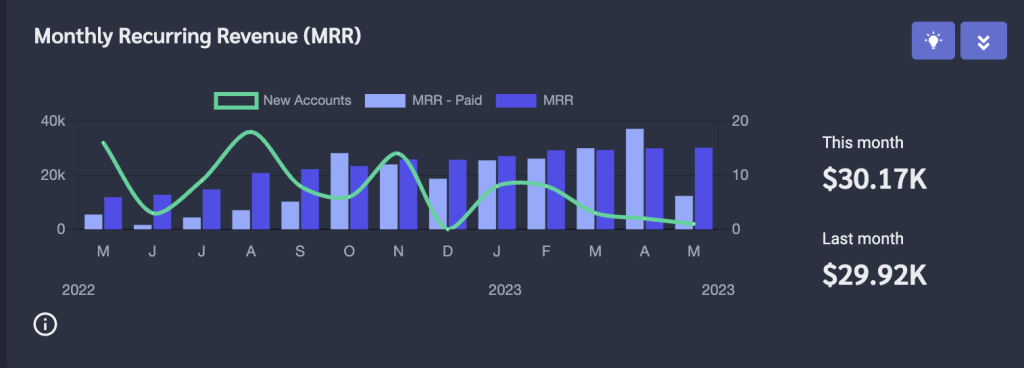
In today’s digital landscape, web hosting subscription businesses face fierce competition and ever-changing customer demands. To navigate this dynamic market successfully, it’s not enough to rely on gut feelings and guesswork. It’s crucial to have a deep understanding of your business’s performance and customer value. By knowing the key metrics to track for your web hosting subscription business, you can gain valuable insights, make informed decisions, and propel your business towards sustainable growth and profitability.
In this article, we will explore the essential metrics that your web hosting subscription business should track. These metrics will help you assess the health of your business, measure customer value, optimize marketing strategies, enhance customer experiences, and drive long-term success. Let’s dive into the key metrics that will unlock the path to achieving your business goals.
Metrics for Financial Success
Monthly Recurring Revenue (MRR) allows you to understand the amount of revenue you can expect to generate on a monthly basis from your subscription customers. By tracking MRR, you gain visibility into the stability of your revenue streams, enabling better financial planning and forecasting. This predictability is valuable for budgeting, resource allocation, and making strategic business decisions.
Monitoring changes in MRR over time helps you assess the growth and expansion of your business. By tracking MRR on a regular basis, you can identify trends, measure the impact of marketing campaigns or pricing changes, and evaluate the effectiveness of your customer acquisition and retention strategies. Increasing MRR indicates business growth. While a decline may signify issues that require attention, such as customer churn or competitive pressures.

Average Revenue per User (ARPU) is a crucial metric for subscription businesses. As it provides a detailed analysis of each user account’s financial contribution. Calculated by dividing the total monthly recurring revenue by the total number of subscribers, including both paying and freemium users. ARPA allows you to understand the revenue distribution among different subscription tiers.
Monitoring ARPA helps identify trends in subscription behavior. An increasing ARPA indicates a rise in premium subscriptions. While a declining ARPA may suggest a decrease in premium subscriptions or an increase in lower-priced plans. Additionally, ARPA helps assess the sustainability of your business model. By determining if the revenue generated by paid subscriptions can support any free plans offered. Or if the free plans effectively convert users into paying subscribers.
By leveraging ARPA as a key metric, subscription businesses can make informed decisions on pricing strategies, package offerings, and overall financial sustainability. It offers valuable insights into revenue dynamics and guides growth strategies for long-term success.
Customer-centric Metrics
Customer Lifetime Value (LTV) provides valuable insights into the long-term value of your customers and their impact on your business’s success. LTV helps you make informed strategic decisions regarding customer acquisition, retention, and overall business growth. By understanding the value each customer brings over their entire relationship with your business, you can allocate resources effectively, tailor marketing efforts, and optimize customer experiences. Tracking LTV allows you to identify high-value customer segments, prioritize retention efforts, and allocate marketing budgets to acquire customers with the highest potential lifetime value.
LTV enables you to assess the return on investment (ROI) of your customer acquisition and retention strategies. By comparing the cost of acquiring and serving a customer with their estimated lifetime value, you can gauge the effectiveness and profitability of your marketing campaigns and customer retention initiatives.

Customer churn refers to the rate at which customers discontinue their subscription or stop using your services. It is crucial for understanding and managing customer retention by analyzing the reasons behind customer churn. Such as pricing, service quality, or competition, you can identify areas for improvement and take proactive measures to reduce churn. It helps you pinpoint potential pain points in the customer journey. Also to implement targeted strategies to enhance customer satisfaction, loyalty, and ultimately, retention.
Customer churn has a direct impact on your revenue and business growth, even more for subscription businesses. Tracking churn helps you quantify the financial implications of losing customers over time. By understanding the revenue lost due to churn, you can develop strategies to mitigate its effects. Such as implementing customer loyalty programs, improving customer support, or refining your product offerings.
Metrics for Expansion
Conversion Rate is a spellbinding metric that transforms mere website visitors into devoted customers. Learn the art of optimizing your website and marketing strategies to entice visitors to take the desired action. Whether it’s signing up for a subscription, making a purchase, or engaging with your services. Conversion Rate provides insights into the efficiency of your customer acquisition strategies. It measures the percentage of website visitors who take the desired action, such as signing up for a subscription or making a purchase. By tracking Conversion Rate, you can assess the effectiveness of your website design, user experience, and marketing campaigns in converting visitors into customers.
Conversion Rate directly impacts the revenue generation potential of your subscription business. A higher Conversion Rate means more customers are successfully converting, resulting in increased revenue. Increasing the Conversion Rate helps you make the most of your marketing budget. Ensures that you are capitalizing on the traffic you already have. Driving revenue growth, and improving the overall profitability of your subscription business.
Metrics for Satisfaction and Loyalty
Tracking Net Promoter Score (NPS) and Customer Satisfaction (CSAT) is highly beneficial for a subscription business as they provide valuable insights into customer loyalty, satisfaction, and overall business performance. By tracking NPS and CSAT, you can identify loyal customers who are likely to continue their subscriptions and become brand advocates.
High scores indicate a positive customer experience, leading to improved customer retention rates. By understanding the factors influencing customer loyalty and satisfaction, you can make informed decisions to enhance customer experiences and strengthen customer relationships. Low NPS or CSAT scores highlight areas where your subscription business may be falling short of customer expectations. By analyzing customer feedback associated with these scores, you can identify pain points, address customer concerns, and make necessary improvements to your product, service, or customer support. Implementing these improvements can lead to increased customer satisfaction, higher retention rates, and positive word-of-mouth referrals, ultimately driving growth and expansion for your subscription business.
Conclusion
In conclusion, the world of subscription business is rich with metrics that hold the key to unlocking growth and success. From financial metrics like Monthly Recurring Revenue (MRR) and Average Revenue per User (ARPU), to customer-centric metrics like Customer Lifetime Value (LTV) and Customer Churn, each metric provides valuable insights into different aspects of your business.
By tracking and analyzing these metrics, subscription businesses can make informed decisions, optimize their strategies, and drive expansion. Metrics like the Conversion Rate empower businesses to attract and convert website visitors into loyal customers. Additionally, NPS and CSAT help gauge customer loyalty and satisfaction, enabling businesses to improve customer experiences and drive retention.
The key takeaway of this article ‘key metrics to track for your web hosting subscription business’ is that these metrics are not standalone measurements but interconnected pieces of a puzzle. It is the holistic analysis of these metrics that provides a comprehensive understanding of your business’s health, growth potential, and areas for improvement.
In the dynamic world of subscription business, success lies in the ability to adapt, innovate, and leverage data-driven insights. By consistently tracking and leveraging the right metrics, subscription businesses can position themselves for sustained growth, customer loyalty, and long-term profitability.


